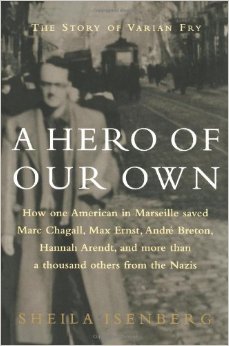A Hero of Our Own: The Story of Varian Fry
Sheila Isenberg
Random House 2001
349 pages
The story of Varian Fry is perhaps less well known than that of Oscar Schindler, but to some he became known as the "American Schindler" or The Artist's Schindler". In 1940, Fry was sent to France by the Emergency Rescue Committee in New York, with a list of two hundred names and only three thousand dollars in his pocket. The list was made up by the Museum of Modern Art in New York and Eleanor Roosevelt, among others. Those on the list were mainly artists, scientists and writers, sculptors who were on the Nazi black list and considered "degenerates". Outlawed and outcast, they had left their countries of origin and were living in France.
This book describes Fry’s activities in Marseille, where he set up The American Rescue Center, and describes the methods by which he was able to support and save many of those on his list and many others who were not on his list. The book mentions those who played a key role in assisting Fry, including Americans, Miriam Davenport, Mary Jayne Gold, Charlie Fawcett and Hiram Bingham IV, the American Vice-Consul in Marseille. Their lives were permanently in danger.
Another person mentioned in the book is the American heiress, Peggy Guggenheim who was in France buying art for her Art Museum in New York. Leaving Paris shortly before the Nazis arrived, for Marseille, she met Fry. She generously contributed money to the Center and became involved in helping him with his rescue activities, before returning to the USA in 1941. In 1942 she put on an exhibition including some of the art she had purchased whilst in France.
Fry encountered indifference at the American Consulate in Marseille. On arrival,
"the receptionist, a "hard-looking peroxide blonde" named Mme. Delapre, told Fry the Visa Division was a quarter of an hour out of town and reachable by trolley. He rode the trolley, along with a tired looking, dusty crowd, and disembarked when they did. While the others formed a straggly line in front of the building, Fry, not a patient man, entered through the front door. A guard yelled at him but he quickly said, "I am an American". He was allowed to wait in the hall, but after ten minutes another guard chased him out. In the street, Fry waited for a while among the crush of refugees. Finally, unaccustomed to the heat and sun, he returned to town in late afternoon, without ever seeing the US counsel. He was dismayed at this first glimpse of his country's attitude toward the ragtag foreigners.
Among those Jewish artists saved by Fry and his team were artist Marc Chagall and sculptor, Jacques Lipschitz. A chapter in the book is devoted to the Lipchitz's escape from France with his wife, poetess Berthe Kitrosser. Lipchitz said of Fry later "In some ways I owe him my life…..I did not want to go away from France. It was his severe and clairvoyant letters which helped me finally to do so…."
Chagall, whose work was once revered, was now termed as one of the "degenerate" artists. The Nazi regime criticized his work, and had even burnt some of his work, yet he still didn't see any reason to leave France. Only in 1940 after they lost their naturalized French citizenship did they realize the danger they were in, especially after Chagall was briefly arrested. Bella, Chagall's wife immediately turned to Fry for help and he was able to get him released, but they were trapped in Vichy France with no exit visas. However, Fry bought them passage tickets and signed an affidavit certifying to Chagall's moral character and financial independence. Eventually Marc and his wife Bella, were able to leave and cross the French-Spanish border. Arriving in Lisbon they sailed for New York and arrived there in June 1941. The Chagall's daughter Ida arrived later by boat, carrying a large case full of Chagall's works.
This book can assist the teacher to introduce to students, historical content, and religious and moral values, while personalizing events of the Holocaust. This important historical lesson can be taught through various disciplines such as history, religion, civics, and literature.
Yad Vashem has recognized Americans, Varian Fry and Waitstill and Martha Sharp as Righteous Among the Nations. Against all odds, they risked their lives to save Jews during the Holocaust. To read more about their heroic actions, please open the following links:
- Varian Fry
- Waitstill and Martha Sharp







